In Game 1 of the 2015 World Series, Royals leadoff hitter Alcides Escobar swung at the first pitch he saw.
In Game 2 of the 2015 World Series, Royals leadoff hitter Alcides Escobar swung at the first pitch he saw.
Before Game 3 of the 2015 World Series, Jason Kendall—now a Royals coach—says if he was in charge of the Mets, he’d deck Esky on the first pitch. Since great (and possibly warped) minds think alike, that’s exactly what Mets starting pitcher, Noah Syndergaard, does.
If you forgot what that looked like, here you go:
The pitch is so far up and in, it doesn’t even register on MLB’s strike zone chart and as you might imagine the Royals weren’t too happy about that.
The Line You Don’t Cross
TV announcer Harold Reynolds says Syndergaard “had to do it” because coming up and in is the traditional way of making a hitter uncomfortable: put the hitter on his backside and then see if he’s still willing to lean out over the plate and hit the outside pitch. Do not let the hitter stand there feeling like a million bucks in new $100 bills; come inside and remind him that you’re in charge and he shouldn’t get too comfortable.
So up and in was not a problem; up above the shoulders was.
More than once I’ve written that a Royals pitcher needed to make an opposition hitter “uncomfortable” by throwing inside. I said the same thing about Daniel Murphy; he’s crowding the plate and some KC pitcher needs to put him on his ass.
(I’m remarkably brave when I’m not the one getting thrown at or the one doing the throwing and then standing on the mound waiting to see if I have to fight a pissed-off hitter.)
But if a pitcher wants to send a message, he does it with a pitch below the shoulders because once you get higher than that you’re talking about the head and enough brain damage to get you a position in the Trump Administration. In the history of Big League Baseball only one batter has died from getting hit in the head (Carl Mays hit Ray Chapman, look it up) and nobody’s eager to become the second batter to die from getting hit in the head with a baseball.
Anybody remember Brett Lawrie?
Kelvin Herrera sent a message to Lawrie when he threw at him and the pitch was at least shoulder high—if not higher. Just in case Brett didn’t get the message, Kelvin pointed at his own head. Lawrie complained about the same thing that the Royals are complaining about now.
You can come inside, just come inside below the shoulders.
And Now Give Syndergaard Some Credit
Feel free to disagree and I’m pretty sure some of you will; but at least Syndergaard stood behind what he did. He flipped Alcides Escobar, but didn’t try to claim it was an accident, which is what a lot of pitchers do: throw at a guy and then pretend the ball got away from them.
Syndergaard hinted that he was going to dump Escobar, did it and then upped the ante when he invited the Royals to come meet him at 60 feet, 6 inches if they had a problem with that.
After I told Jason Kendall what Syndergaard said, Jason announced: “Now I like him.”
And Syndergaard did it in a game in New York which meant he had to go to the plate himself and might get thrown at in retaliation and that takes way more balls than doing it in a game with a Designated Hitter.
The Royals Do Not Respond
So Syndergaard flips Esky and later I hear the Royals had a quick meeting to decide if Yordano Ventura should flip Mets leadoff hitter, Curtis Granderson (the obvious target) but the Royals decide Yordano’s not the right guy to do it.
As we’ve already seen this season, Yordano can get way too amped-up and the Royals decide if you ask Yordano to start throwing at people, who knows where that might lead and pretty soon you’d have the Sharks and the Jets without the music and dancing. Better to take care of that business at a later date and the best response would be to win the World Series.
(I ask one of the people involved in that meeting what Jason Kendall wanted to do and the response was: “Kendall wants to hit everybody.”)
With one pitch Noah Syndergaard said “game on” and we’re off to a rambunctious start.
The Rest of the Game
For the next five and a half innings things look competitive—it’s Mets 5, Royals 3 going into the bottom of the sixth—and I could talk about each play and how it wound up 9-3, but that’s what everybody else does and my deal is finding important moments that tell us something about baseball and how it’s played.
So let’s stick with that and just say Yordano Ventura had a bad night that included forgetting to cover first base.
Not the sign of a pitcher who has his shit together.
Ventura only throws three and a third innings and the Royals have to use six relievers to finish the game and as someone once said to me and I’ve repeatedly repeated: use enough relievers and you’ll find one who doesn’t have it and in Game 3 that’s Franklin Morales.
He gives up four runs in 1/3 of an inning to make it 9-3.
And using six relievers in a loss means the Mets get an extra look at:
Danny Duffy
Luke Hochevar
Franklin Morales
Kelvin Herrera
Ryan Madson
And…
Kris Medlen
One of the advantages relievers have going for them is batters don’t get to see them that often and the more a batter sees a pitcher the more he learns about him and that improves his chances of hitting him. So the Royals not only lose Game 3, they make the rest of the Series just a little bit harder for themselves.
And now let’s examine two plays that can teach us something.
Syndergaard’s Hit
In the bottom of the third inning Noah Syndergaard comes to the plate and not only does Yordano Ventura not stick a fastball in his ribs, Ventura pitches Syndergaard down and away and after Syndergaard looks at two strikes—a cutter and a sinker—Ventura and Salvador Perez do Noah the favor of throwing him an 84-MPH curve which Syndergaard’s bat speed can handle and he singles to right field.
And Syndergaard scores four pitches later when the other guy they didn’t hit—Curtis Granderson—homers.
In 2015 Noah Syndergaard had 43 at-bats and struck out 26 times and it wouldn’t surprise me if someone asked why are we throwing that guy 84-MPH curveballs because next time Syndergaard came to the plate he was facing Danny Duffy and Danny threw him five fastballs 95-MPH or more, all at the top of the zone and guess what—Syndergaard struck out again.
There are guys you have to fool and guys you don’t and when you see one of those guys, don’t mess around, blow him out of the water.
Alex Gordon Makes the First Out at Third Base
In the second inning Salvador Perez singles and Alex Gordon singles and Alex Rios singles and Salvy scores on that last hit, but Gordon is thrown out trying to go first-to-third which seems to break one of Baseball’s 10 Commandments:
“Do not make the first or last out at third base and when you’re on the road make sure your wife and girlfriend stay in different hotels.”
That last bit is self-explanatory, but the part about third base is based on the idea that if you’re already in scoring position, don’t get thrown out at third base with zero outs because you still have three more chances for someone to get a hit and drive you in.
And with two outs you’re probably going to score from second base on a hit because you don’t have to wait to see if the ball drops in; you can leave right away and get a good jump.
But in baseball there are always exceptions—no exceptions.
In this case, the exception to the base-running Commandment is Yordano Ventura being on-deck. In his career Yordano has had 10 at-bats and struck out in eight of them. He’s also successfully bunted just once and that was in 2014.
So not being able to count on getting anything out of Ventura, Gordon is running the bases like there’s already one out because odds are, there will be shortly.
Now here’s the deal on that:
Unlike the rest of us who can wait to see a play’s outcome and then decide if it was a good play or a dumb one, ballplayers and coaches have to make decisions before they know the outcome and the Royals have decided to challenge the Mets defense whenever possible.
In Game 5 Eric Hosmer is going to do the same thing and since it worked, nobody will complain about it.
You gotta take the bad with the good and you can’t have Hosmer’s crazy-ass dash home in Game 5 if you won’t accept Gordon getting thrown out at third base in Game 3. If something works 7-ouy-of-10 times those are pretty good odds, but it still doesn’t work three times and if you won’t accept those three failures you can’t have the seven successes.
If someone had torn Gordon a new one for not being more cautious on the base paths, does Hosmer attempt to score two games later?
You’re running the bases aggressively or you aren’t and the Royals have decided to run the bases aggressively because in the long run it will pay off more often than it doesn’t and in Game 5 it’s going to pay off Big Time.
(After Gordon gets thrown out, Yordano does get a bunt down—remember what I said about exceptions—and moves Rios to third base and he scores on a passed ball, more of the shoddy defense the Royals count on seeing from the Mets.)
Next Up:
So now the Mets feel like they’re right back in the Series because ten teams have started 0-2 and still won a World Series (not easy/not impossible) and in Game 3 they’re starting Steven Matz—4-0 with a 2.27 ERA—and the Royals are once again turning to Chris Young—11-6 with a 3.06 ERA.
Win Game 4 and the Mets like their chances.
This thing’s far from over.

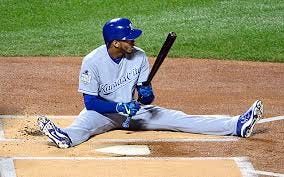
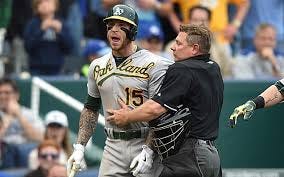
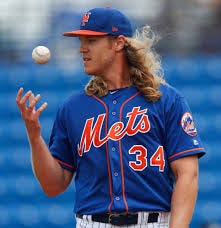
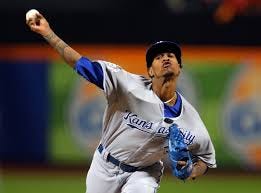
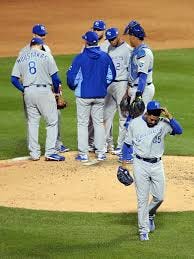
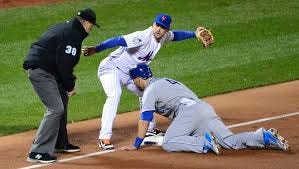

Hmmm. I don't recall the Great Dane's pitch being THAT close to Esky's head. I recall it going about five feet over the plate, more centered. Anyway, I loved Esky's head-nodding response, which I read as "Yeah, that's about right. Should've seen that coming."
I had Alex being thrown out at third as another TOOTBLAN. Thanks for pointing out the reasoning.
Why on earth was Franklyn Morales pitching in a game that the Royals were not two touchdowns ahead or behind? Morales was the textbook example of garbage-time pitching. Never got Ned's thinking on that move.
BTW, without giving the outcome away, Pete Rose is the only talking head who accurately predicted the Series before Game 1. Just saying.